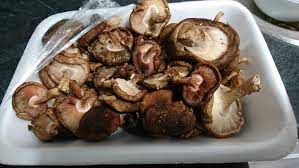The transition of white mushrooms to brown is a natural ageing process that can sometimes indicate a change in texture and flavour. While some browning is normal and safe to eat, if the mushrooms become slimy or have a strong, off-odor, they should be discarded because they have likely gone bad and may cause food poisoning if consumed. It’s always best to err on the side of caution and avoid eating mushrooms with an unusual appearance or odour.
Brown mushrooms with a slimy texture or a strong off odour may be spoiled and should not be consumed as they can cause food poisoning. In terms of flavour, as mushrooms age and change colour from white to brown, their texture softens and their flavour becomes more pronounced. Brown mushrooms, according to some, have a nuttier or earthier flavour than younger, white mushrooms. However, the flavour of brown mushrooms can vary depending on the type of mushroom and the growing conditions.
In terms of nutritional content, there is no discernible difference between brown and white mushrooms. They are still high in potassium, copper, and vitamin B. However, because the nutritional value of mushrooms can degrade over time, it’s best to consume them as soon as possible after purchasing or harvesting.
Steps to prevent mushrooms from turning brown
- Store them correctly: Store mushrooms in a paper bag in the refrigerator. This helps to absorb moisture and prevent browning.
- Use lemon juice or vinegar: Both lemon juice and vinegar are acidic and can help to slow down the oxidation process that causes browning. Simply brush the mushrooms with a solution of lemon juice or vinegar before cooking.
- Cook them quickly: The longer mushrooms are exposed to air, the more quickly they will turn brown. To prevent this, cook them quickly over high heat.
- Keep them covered: Covering the mushrooms while cooking can help to prevent air exposure and slow down the browning process.
- Blanch them first: Blanching mushrooms in boiling water for a few minutes before cooking can help to prevent browning. Just be sure to drain them thoroughly before cooking to avoid a watery dish.
By following these tips, you can help to prevent mushrooms from turning brown and keep them looking fresh and flavorful.

Can you eat mushrooms that are turning brown?
Yes, you can eat browning mushrooms as long as they don’t have a slimy texture or a strong, off-odor. Mushroom browning is a natural ageing process that can sometimes indicate a change in texture and flavour. Brown mushrooms, according to some, have a nuttier or earthier flavour than younger, white mushrooms. If the mushrooms become slimy or have a strong, off-odor, they should be discarded because they have likely gone bad and may cause food poisoning if consumed. It’s always best to err on the side of caution and avoid eating mushrooms with an unusual appearance or odour.
Is it OK to cook mushrooms with brown spots?
Yes, cooking mushrooms with brown spots is generally acceptable as long as they do not have a slimy texture or a strong, off-odor. Brown spots on mushrooms are frequently caused by natural ageing and can indicate a change in texture or flavour. Some people believe that brown-spot mushrooms have a nuttier or earthier flavour than younger, white mushrooms. When cooking mushrooms with brown spots, simply trim away any slimy or discoloured areas and continue with your recipe as usual. If the mushrooms become slimy or have a strong, off-odor, they should be discarded because they have likely gone bad and may cause food poisoning if consumed. It’s always best to err on the side of caution and not eat mushrooms that have a questionable appearance or odor.
Can I cut brown part of the mushroom and use the rest?
Yes, you can use the rest of the mushroom after removing the brown part. If a mushroom has a minor discoloration, it is usually safe to remove it and use the rest of the mushroom. If the discoloration is severe or the mushroom has begun to spoil, it is best to discard it completely.
When removing a discoloured section of a mushroom, make sure to cut deep enough to remove all of the affected tissue, as spoilage can spread quickly through the mushroom. Also, keep in mind that the texture and flavour of the mushroom may have changed slightly where it has begun to spoil.
It’s always a good idea to check the mushrooms for any signs of spoilage, such as an off odor, sliminess, or excessive softness, before using them. If you have any concerns about the freshness of your mushrooms, it is best to err on the side of caution and discard them rather than risking foodborne illness.

How do you know if mushrooms are bad?
Yes, cooking mushrooms with brown spots is generally acceptable as long as they do not have a slimy texture or a strong, off-odor. Brown spots on mushrooms are frequently caused by natural ageing and can indicate a change in texture or flavour. Some people believe that brown-spot mushrooms have a nuttier or earthier flavour than younger, white mushrooms. When cooking mushrooms with brown spots, simply trim away any slimy or discoloured areas and continue with your recipe as usual. If the mushrooms become slimy or have a strong, off-odor, they should be discarded because they have likely gone bad and may cause food poisoning if consumed.
Mold growth: If you see mould growing on the mushrooms, they should be discarded because mould can indicate spoilage and, if consumed, can cause food poisoning.
It’s critical to keep an eye on the freshness of your mushrooms, as eating spoiled mushrooms can result in food poisoning. If in doubt, err on the side of caution and avoid eating mushrooms with an unusual appearance or odour.
Why are my mushrooms turning brown?
Mushrooms turning brown is a natural aging process that occurs as the mushrooms mature. As mushrooms age, their texture and flavor can change, and their color can change from white to brown. This process can be accelerated by exposure to air, light, or heat, which can cause the mushrooms to brown more quickly.
Additionally, some types of mushrooms are naturally more prone to browning than others. For example, crimini mushrooms, which are a mature version of white button mushrooms, are naturally darker in color and are more likely to turn brown as they age.
If your mushrooms are browning more quickly than you would like, you can store them in a cool, dark place, such as a refrigerator, and use them as soon as possible after purchasing or harvesting to minimize browning. You can also store mushrooms in a paper bag, which can help to absorb excess moisture and slow down the browning process.
Are brown mushrooms bad?
Brown mushrooms are not necessarily bad, but their condition is important. The mushrooms are safe to eat if they are brown from natural ageing, have a firm texture, and a mild aroma. If the browning is accompanied by a slimy texture or a strong, off-odor, the mushrooms have most likely gone bad and should not be consumed because they can cause food poisoning.
It’s critical to keep an eye on the freshness of your mushrooms, as eating spoiled mushrooms can result in food poisoning. If in doubt, err on the side of caution and avoid eating mushrooms with an unusual appearance or odour.

How to tell when mushrooms go bad
There are several indicators that mushrooms have gone bad and should not be eaten:
Fresh mushrooms should have a mild, earthy aroma. They have likely gone bad if they have a strong, pungent, or sour odour and should not be consumed.
Examine the appearance for any visible signs of mould or discoloration. If the mushroom has a green, blue, or black furry mould covering it, it is definitely bad and should be discarded. If the mushroom has darkened or changed colour, this may indicate that it has gone bad.
Fresh mushrooms should have a firm and crisp texture. They have most likely gone bad if they have become slimy, soft, or have a rubbery texture.
Take a small bite if you are unsure about the condition of the mushrooms. If the mushroom has gone bad and tastes sour or bitter, it should be discarded.
To prevent mushrooms from spoiling, store them properly and use them within a week or two. If you are unsure about the condition of your mushrooms, it is always best to err on the side of caution and avoid eating them.
Is it OK to eat mushrooms that are turning brown?
Browning of mushrooms is a natural ageing process that can occur over time, even if they are properly stored. Brown mushrooms are generally safe to eat, but their texture and flavour may have changed. If the mushrooms have only slightly browned and show no other signs of spoilage, such as a strong odour or visible mould, they are still likely edible. If the browning is severe or the mushrooms show other signs of spoilage, it is best to discard them to avoid the risk of foodborne illness.
It’s always a good idea to inspect mushrooms before using them to determine if they are still fresh and safe to eat. If you have any doubts, it’s best to err on the side of caution and not consume them.
How to keep sliced mushrooms from going brown
Steps you can take to help slow down the browning of sliced mushrooms:
- Store them in the refrigerator: Keeping sliced mushrooms in a sealed container in the refrigerator can help slow down the oxidation process that causes browning.
- Use a lemon juice or vinegar solution: Soak the sliced mushrooms in a solution of lemon juice or vinegar for a few minutes before storing them. This will help to maintain their color and freshness.
- Keep them covered: Cover the sliced mushrooms with a damp paper towel or wrap them in plastic wrap to help prevent air from reaching them and causing oxidation.
- Use them quickly: The faster you can use the sliced mushrooms, the less time they will have to brown. So if you have sliced a large amount of mushrooms, it’s best to use them as soon as possible.
It’s important to note that while these steps can help slow down the browning process, they won’t stop it entirely. Sliced mushrooms will naturally begin to brown and spoil over time. To ensure that they remain fresh and safe to eat, use them within a day or two.
How do you keep mushrooms from turning black when cooking?
There are a few things you can do to keep mushrooms from turning black while cooking:
Cook quickly: Instead of slow-cooking the mushrooms, cook them quickly over high heat. This will aid in the preservation of their colour. Cook the mushrooms in a non-reactive pan, such as stainless steel or ceramic, rather than an iron pan. Iron has the potential to turn the mushrooms black.
Adding acid to the pan, such as lemon juice, vinegar, or wine, can help keep the mushrooms from turning black. The acid in these ingredients will help to keep them from oxidising.
Don’t crowd the pan: Leave enough room in the pan for the mushrooms to cook without touching. Overcrowding the pan may cause the mushrooms to steam rather than sauté, resulting in colour loss.
Proper storage: Keep the mushrooms in a cool, dry place rather than a warm, humid environment. This will help to keep bacteria and other organisms at bay, which can cause the mushrooms to deteriorate and turn black.
You can help keep your mushrooms looking fresh and appetising when you cook them by following these tips.





